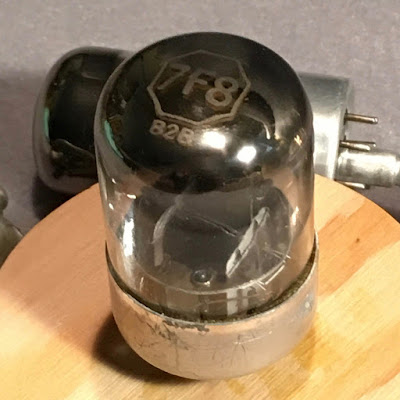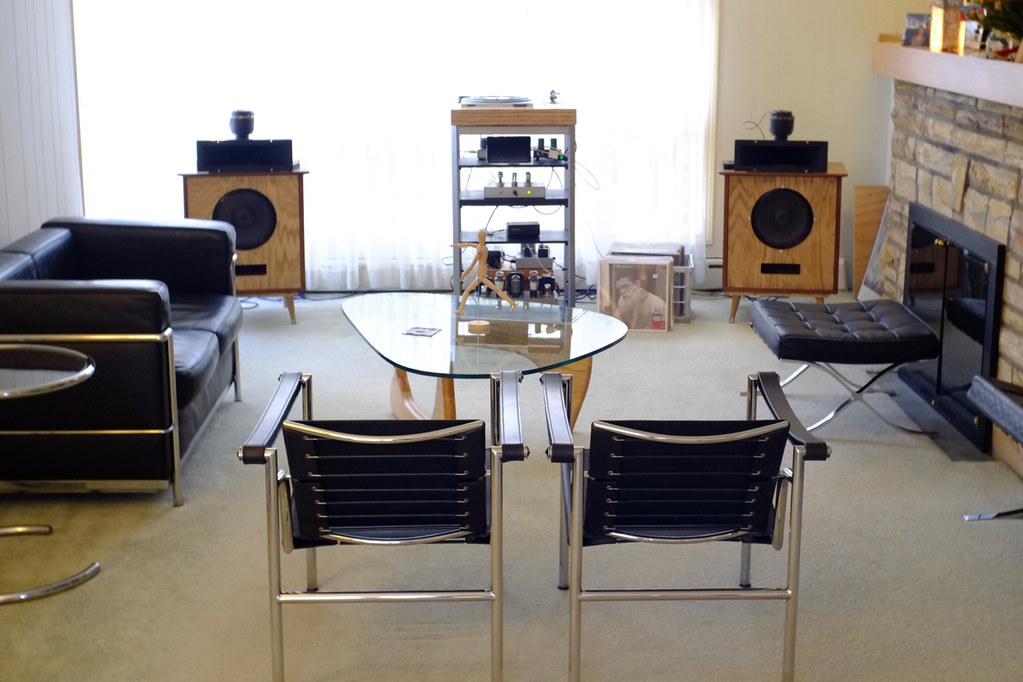Wednesday, January 17, 2018
Wednesday, January 3, 2018
Altec 2-way XO Redux
 |
| JEL N1600 Crossover |
 |
| JEL N1600C + HF EQ optimized for the 802 driver fitted with the original 16 ohm 20275 diaphragm |
The above crossover circuit, as discussed in this previous post, was optimized for my cherished pair of green Hammertone Altec 802Ds fitted with the original aluminum 20275 diaphragm, which has an aluminum wound voice coil. To my ears, this diaphragm has a more prominent midrange response which necessitates rolling off the upper midrange/lower high frequencies of the 414A woofer for flatter response.
 |
| JEL Universal Altec 2-way XO |
For the Altec 802 driver equipped with the 34852 (16 ohm) or 34647 (8 ohm) diaphragms, which have copper wound voice coils, I recommend the 6dB/octave crossover circuit below which is hinged at around 2500 Hz + high frequency EQ boost. This aluminum diaphragm has less energy in the upper midrange giving a tonal balance that sounds more extended in the high frequencies compared to its 20275 predecessor. In this implementation the Altec 414A woofer is connected as a full-range driver inspired by Joe Roberts.
 |
| JEL Universal Altec 2-way XO with HF EQ circuit |
I've also used this crossover successfully with the Altec 802 driver fitted with the Symbiotik diaphragm, Emilar EA/EC175 and Renkus-Heinz SSD1800/1400. Please take note of the different capacitor values for 16 or 8 ohm drivers.
Simplest Crossover
If you want the simplest crossover, my buddy Joe Roberts listens to his Altec 414A/802/32 set-up with the woofer in full-range mode + a 1.5uf paper in oil cap for the compression driver, no L-pad or HF peaking EQ circuit. See his Audiokarma post for more details.
Sunday, December 24, 2017
Happy Holidays and a Great New Year to All!
2017 Index
January: Noguchi FInemet Preview
February: Budget SE OPTs + Vostok Bezel Mods
May: Electrovice 209-8A + Dad
August: Lens Filter Ring Vise
September: Shure Mic Transformers as SUT
November: Grace 707/Denon DP1250 + Hi-Fi in Manila
Friday, December 15, 2017
JE Labs Loctal Preamp
Motivated by Ding's octal version of the 834P, I quickly got my hands dirty punching out and painting a chassis.
Loctal tubes
The concept of this project was to build a full function stereo preamp utilizing loctal tubes based on the schematics below.
Preamp circuit
!!!WARNING!!!
The voltages found in this circuit can be lethal!
Build at your own risk!!!
 |
| Power Supply |
 |
| 5AZ4 rectifier = 5Y3 on a loctal base |
Line Stage
 |
| The 7AF7 is very similar to the 7N7 and 6SN7 but has slightly less transconductance and inter-electrode capacitance |
 |
| 7N7 = loctal based 6SN7 |
Phono
The stock EAR 834P circuit (above) used all high-mu 12AX7s with the second stage capacitor coupled to the cathode follower stage. While preparing this blog entry, I remembered that my dearly departed friend, mono aficionado Brian monofantastico Clark, grafted his own interpretation of an EAR 834P phono stage to his SE 801 mono integrated amplifier. He was an active participant in this discussion of 834P modifications initiated by Thorsten Loesch.
Ding's octal version of the 834P uses all 6SL7s with the second stage direct coupled to the cathode follower stage. Without ever sounding harsh, Ding's octal 834P sounded brighter and had a refreshing airiness in the high frequencies compared to my darker and more midrange oriented RCA derived phono preamp. Even if I never heard an original EAR 834P, I now have a good idea why it was received with great enthusiasm.
 |
| 100Hz/1kHz/10kHz square waves (top = input/bottom = output) from the Loctal EAR 834P phono section |
 |
| 7F7 = 6SL7 on a loctal base |
Although the 7B4 and 7B6 are high-mu loctals, they are single triodes. AFAIK, the 7F7 is the only high-mu twin triode available in loctal and was the obvious choice for the 1st and 2nd stages of the 834P circuit given my chassis configuration.
Tube rolling loctal style
 |
| I've been tweaking and listening to this preamp for the past 6 months. |
During my Dyna PAS hacking days, the 12AU7 always sounded gutsier in line stage and cathode follower applications than the 12AX7 because it had lower Rp and pulled more current. Thus, there was some room to voice the 834P circuit through the cathode follower section.
 |
| Warning: 7F8 is NOT plug-in compatible with the 7N7 and 7AF7 |
I initially set up the phono section to use the unique 7F8 loctal in the cathode follower position, hoping that the 7F8's greater transconductance will produce a darker and more robust sound. But ultimately, it was the ubiquitous 7N7 (loctal 6SN7) that gave me the tonal balance I wanted, with the 7AF7 as alternate.
With an amplification factor of 48, the 7F8 may not have enough gain as a phono preamp with the RIAA EQ in the negative feedback loop. However, it was too much for a zero feedback single stage line amp.
Typically, I don't split halves of twin triodes for left and right channels. I made an exception in wiring this line stage so that I could exploit the 7AF7 vs. 7N7 comparisons and usage options.
My ears finally chose the 7AF7 as the voltage amplifier for the line stage. The slightly lower transconductance and amplification factor mimics the exotic tonal qualities of its grandad, the 76. Each half of the 7AF7 is direct coupled to half of a 7N7 configured as the cathode follower. This combination is as close as I could get to my 76/6SN7 line stage.
But don't limit yourself to this report, use it as a starting point for your loctal tube rolling adventure. 😉
Which is better?
or
Both are here to stay. 😎
🎅🎅🎅 Happy holidays and merry listening! 🎄🎄🎄
Friday, December 1, 2017
Line Transformers Redux + Art Dudley + AQ Dragonfly Black
My boring digital life
 |
| Tascam DA-P1 courtesy of pgr.tv |
Probably the most significant digital audio gear I ever owned was the Tascam DA-P1 DAT recorder. This machine recorded my recitals, chamber music performances and served as a back-up and playback deck for my CD projects from the mid 90s until the early 2000s. It was rendered obsolete when HD based recording became the industry standard.
 |
| DAC in the Box courtesy of Wiki Commons |
I never invested in a high-end CD player. The most I ever did for CD playback was get an Audio Alchemy DAC in the Box fed by the digital output of a consumer grade Philips CD player. When the Philips CD player conked out in the early 2000s, it was replaced by a Sony DVD/SACD player.
Line transformers as Digital Sound Processors
 |
| Tamura line transformers |
Ever since I inserted a pair of Tamura 600:600 line transformers as a digital sound processor (DSP) between the CD player/DAC and my preamp line inputs, I didn't see the necessity of upgrading the Audio Alchemy DitB. I don't know if this holds water but my empirical rational for this is, magnetic coupling filters digital artifacts and RFI noise from the DAC output, which is manifested as harshness to my ears.
Art Dudley Listening
If I don't consider the few issues of Stereo Sound Tube Kingdom and MJ I picked up in Tokyo in 2015, it's been a long while since I subscribed to, let alone bought, a single issue of Stereophile, The Absolute Sound or any audio magazine. After the demise of Sound Practices in the late 90s, the only audio magazine I read was Art Dudley's Listener.
Although I've never had a chance to meet Art personally, I know he is a fine gentleman. I've been following his Stereophile column online and he has given credit to my musings on the open baffle as well as the Altec 755A. He even sent me a private message when my father passed away earlier this year. I was looking forward to meeting him at the Capital Audio Fest 2017 but missed the event because it coincided with the Harrisburg Symphony's November Masterworks.
 |
| iPad mini + UTC A20 line transformers |
Due to my current location, access to quality FM programming is practically nil. I've relied mainly on digital streaming via iPad mini + DSP to widen my choice of free music. 😜
USB DAC
 |
| Audioquest Dragonfly Black V1.5 |
When I realized that the iPad mini's internal DAC can be by-passed through an Audioquest Dragonfly USB DAC, I searched the archives of Art Dudley's Listening to see if he had anything to say about the AQ Dragonfly USB DACs. After getting Art's stamp of approval, I placed an order for the cheaper Black.
 |
| Stereo > Mono |
Whether I was listening in mono or stereo, this was the best $100 (ok, + $38 for the Lightning to USB 3 Camera cable adapter) investment I ever made in digital audio. The degree of improvement was at least as significant, if not greater than, when I started playing with transformer DSP(s) between the digital source and my line preamp input(s).
 |
| Stereo set up = AQ Dragonfly Black > a pair of UTC A20 wired 1:1 > preamp line stage |
The combination of the iPad mini + AQ Dragonfly Black + DSP = smooth analog-like detail across the audio bandwidth. So I take back my word, I need this USB DAC. 😎
Thank you Art and here's to us meeting some time soon. Cheers! 🍻
Thank you Art and here's to us meeting some time soon. Cheers! 🍻
Tuesday, November 14, 2017
November 2017 Hifi Show
I actively participated in this annual event for nine consecutive years with my Harana/Tono/Setup buddies but will break the tradition this year. 😞 This is a must see for every audio/video enthusiast based in Manila. 👍👍👍
Subscribe to:
Posts (Atom)















